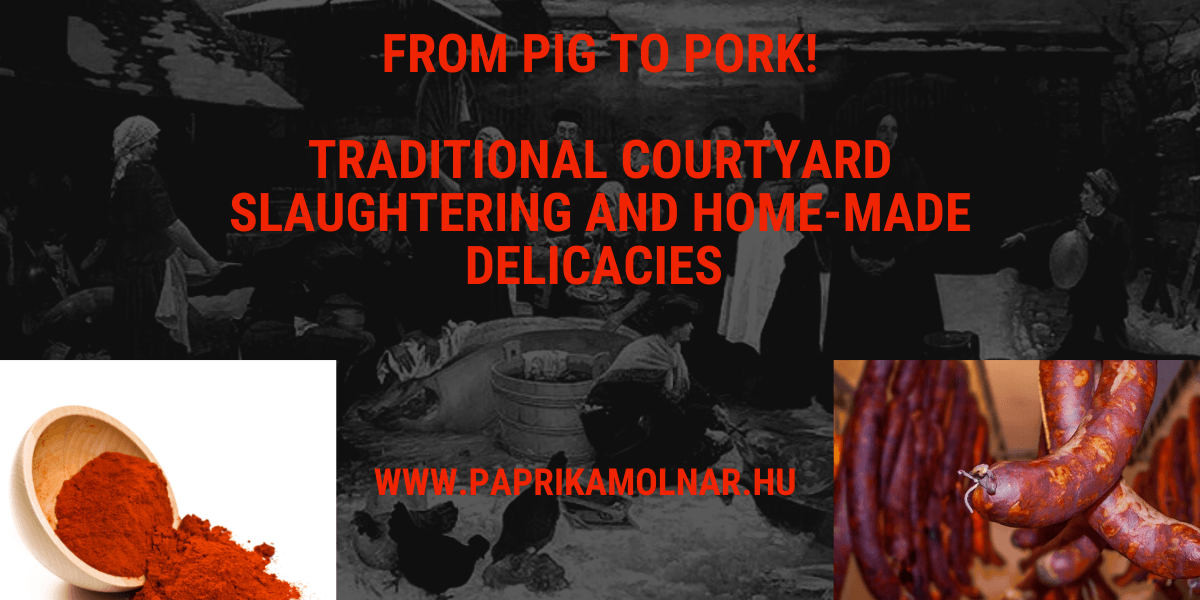While the old paprikafarmers around Szeged were busy picking their harvest, during the beginning of September, obviously other events of the economic life took place parallelly. Already at that time, much attention was paid to the preparation of pig slaughtering. For most people the making of hams, sausages and bacon were crucial winter activities and also symbolised a celebration of abundance.
November 30 – pig slaughtering day
People usually started fattening their pig on September 1st. After 3 months – by November 30 – all was set and ready for „St. Andrew – the pig slayer” to fulfill the process of pig slaughter.
By this time, the outside temparatures were much colder so there was no need to worry about the meat going down. But also by then the demand for meat became really big, as the bacon and sausages were symbolic for surviving the winter at many poor families. The meat was consumed during the entire winter season, and served in festive menus on many winterday celebrations as name days, weddings and carnival. As pig slaughtering involved many different tasks, it was important that by the end of November there was no longer any farmer work to do in the fields. Last but not least, by the end of November, the paprika spice, essential for all pork meat, was always freshly milled and easily to get.
Paprika in stuffed cabbage and sausages
Although today the practice of pig slaughtering has changed significantly, like equipment used, certain elements are still resembling the traditional event.
The outside courtyard is basically male-only territory. The man in the family that is most knowledgeable about cutting up meat gets the leading role, being the butcher. Scalding, cutting up an animal, making the marinade, meat frying and stuffing the sausages are some of the most important work processes.
For a really delicious sausage, according to a well-known recipe, every 10 kg of minced meat filling would need to be mixed with some 30 dkg of paprika spice. It can’t be stressed enough that the spice should be freshly made and bought from merchants close to the miller. In addition to paprika, for the mix you will need some 20-22 dkg of salt, 2.5 dkg of pepper and about half a handful of pressed garlic.
Filling home-made sausages in Spain! Could be in Hungary, in our village
While the sausage is being stuffed in the courtyard (sometimes with some spirits flowing), the women in the family are working in the kitchen. Of course, during the slaughter some of the meat is occasionally being consumed by the participants themselves. They are also thinking of the children that are expected to join in the evening singing special songs that bare wittingly refering to the happening. For example: „I also caught an ear – a tail, so give me a piece of the action!”
An indispensable product of a pig slaughtering is stuffed cabbage, containing fresh sausage meat rolled in cabbage leaves that were prepared in sour vinegar all heated in a bright red meat-juice. Many people also prepare a rich stew, which will provide lunch for the next few days and can serve as a generous gift to all that assisted at the event. The red paprika spice is often used to decorate the meat, such as pieces of bacon or kidney marrow.
Without fresh paprika, a pig slaughter is simply unthinkable. In our PaprikaMolnár Paprika Mill & Museum we show many more of such connections and the crucial role that paprika played in many parts of economic life. Visit us!
Tetszett a cikk? Ha szeretne még paprikás és fűszeres témában, heti rendszerességgel cikket olvasni, hírt kapni az ÚJ paprika elkészültéről, iratkozzon fel hírlevelünkre. Subscribe to our Blog and enjoy our Paprika Poster.








